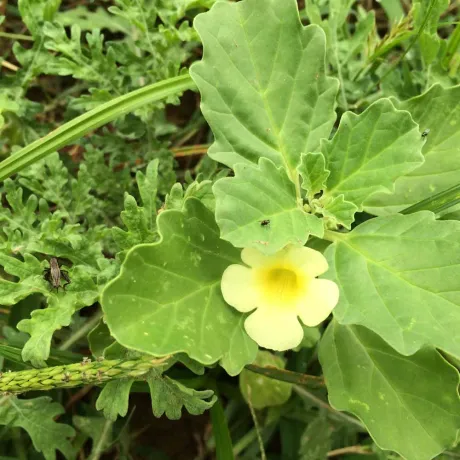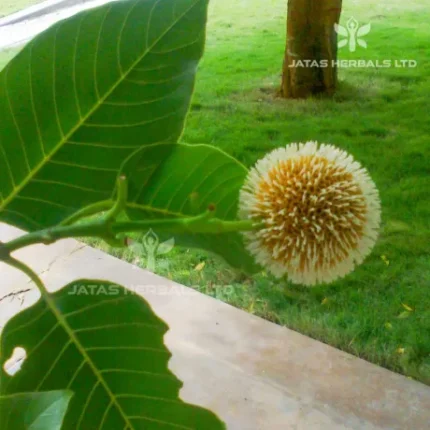The name and synonyms of Gokshura are not found in the vedic literature. Caraka identified it as the best drug for Mutrakrcchra (dysuria) and Vata rogas (C.S.Su.25). It is one of the herbs which is “Mutrala” (diuretic) as well as “Sothahara” (anti-inflammatory). The root is used in Dasamula while the fruit is Vrishya. Bapalalji is of the view that both roots and fruits are to be used along with whole plant in Asmari (Urolithiosis).
Controversial Studies–Quoting his great teacher late Amrtalal P. Pattani, Vaidya Bapalal stated that ‘Tri-Kantaka’ should possess three spines/spurs but not six or four as the case with Tribulus or Pedalium. Even considering the term Gokshura the fruit is not like the hoof of a cow. Another herb Martynia diandra (Pedaliaceae) may be the true Gokshura according to Pattani. Bapalalji is of the openion that Acanthospermum hispidium DC is the real Gokshura. Sivadasa sen considered that bigger variety of Gokshura is the best one (while commenting on Cakradatta) – Nrtyakundaka or Nrtyakundala mentioned by Vagbhata (A.H.Ci.11/30) is considered as another source for Gokshura to Pattani. But Thakur Balvant Singhji described it as Eleusine corocana which is a different plant. In Punjab and Sindh Xanthium strumarium Linn. (compositae) is used for smallpox. Late Dr. Sakharam Arjun considers it as Gokshura.
Different varieties– We come across utilization of two varieties of Gokshura viz, Brihat (Pedalium murex Linn.) and Laghu (T. terrestris) varieties.
Botanical Description–
- terrestris–A small, prostrate, hirsute or silky hairy herb. Leaves-stipulate, opposite, usually unequal, abruptly pinnate; leaflets 4-7 pairs, oblong, mucronate. Flowers- solitary, axillary or leaf-opposed, yellow or white. Fruits-globose, hairy, 5-angled, spinous with 2 long and 2 short spines on each cocci. Seeds- obliquely pendulous. (Flowers and fruits during April-August).
(ii) P. murex– A glabrous annual herb. Leaves- opposite or alternate, petioled irregularly toothed or almost lobed. Flowers- solitary, axillary, with 2 glands at the base. Calyx small 5-partite. Corolla yellow. Stamens 4, didynamous, included, Ovary 2-called. Fruits-hard indehiscent, pyramidal-ovoid capsules with 4 patent spines from base.
Major chemical constituents– (T. terrestris)
Fruits–Chlorogenin, diosgenin, gitogenin, rutin, rhamnose
Roots–Campesterol, sitosterol and stigmasterol, neotigogenin
Aerial parts– astragalin, dioscin, diosgenin, hecogenin, ruscogenin, trillin, furostanol glycoside, spirosterol saponin; terrestrosides A-F saponins C and G etc.
Dosage– Decoction 50-100 ml, powder 3-6 g.
Research works–
(1) Anti-cancer activity– One of the three new steroidal saponins from the fruits of T. terrestris exhibited cytotoxic activity against a human malignant melanoma cell line (Behdir & khan, 2000).
(2) Nephroprotective activity– Nephroprotective activity was evaluated in gentamicin-induced nephrotoxicity (80 mg/kg/day S.C.) in male albino rats, NR-AG-I (Containing C. nurvala, T-Terrestris, D. biflorus & Shilajit) and NR- AG-II (C. nurvala, B. diffusa S. officinarun & B. chinensis) were tested given for 12 days. Urea clearance and microscopical examinations of kidney were performed after the treatment. Gentamicin caused nephrotoxicity as evidenced by significant reduction in urea clearance and was prevented by both formulations. Study of renal microscopy showed necrosis, epithelial loss with granular degeneration and fatty changes in gentamicin treated rats and was reversed by both formulations. But, NR-I Proved to be better formulation (due to presence of T-terrestris)-(Samiulla & Harish, 2001).
- Simultaneous administration of T-terrestries (200g/kg/day p.o.) and gentamycin to female rats decreased gentamycin-induced renal damage in both structural & functional terms (Nagarkatti et al; 1994).
- Lithotriptic property– Aqueous extract of T. terrestris (5 g/kg p.o./day) was tested in 6 male rats in whom hyperoxaluria was induced. 24 hr urinary oxalate excretion reversed to normal, from 1.970.314 to 0.1440.004 mg/mg creatinine (p<0.001) within 21 days of administration of drug …… until 15 days after withdrawl of extract and sodium glycoate (Sangeetha et al; 1993).
An ethanolic extract from fruits showed significant dose dependent protection against urolithiosis induced by glass bead implantation in albino rats (Anand et al; 1994)
The following reports are also available on the clinical effects of Gokshura in urolithiosis Nair P.S. (BHU), 1966; Usha R. (Trivendrum), 1993 & ighantu K.N. (BHU), 1995.
Administration of aqueous extract and a significant significantly reduced urinary oxalate excretion, and a significant raise in urinary glyoxylate excretion is also observed as compared to sodium glycoate fed animals (Sangeet et al; 1994).
(4) Hepatoprotective activity– The hepatoprotective activity of T. terrestrio is reported against CCl4-induced hepatotoxicity in rats (Lee et al, 1992)
(5) Diuretic activity–The decoction of fruits found to possess a moderate diuretic activity in rats (Gujral et al; 1955).
An alkaloid from T. terrestris produced slight rise in B.P. and appreciable rise in kidney volume (Chopra, 1956).
Watery extract of Gokshura possesses similar diuretic activity like urea both in rats and dogs. The diuresis was due to the potassium content of the extract (Karandikar et al; 1960).
(6) Aphrodisiac property–A new original preparation ‘Tribestan’ has been obtained from T. terrestris having a stimulatory effect on sexual functions (Tomova, 1987).





Reviews
There are no reviews yet.